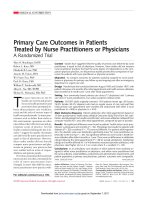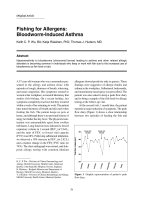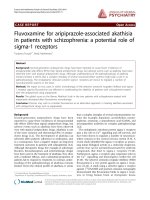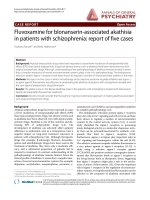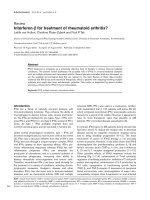Báo cáo y học: "Statins for acutely hospitalized patients: randomized controlled trials are long overdue" doc
Bạn đang xem bản rút gọn của tài liệu. Xem và tải ngay bản đầy đủ của tài liệu tại đây (116.81 KB, 2 trang )
In this issue of Critical Care, Christensen and colleagues
[1] present data suggesting that patients who chronically
take statins have improved survival during acute
hospitalizations and for at least 1 year thereafter. Statins
are now recognized to have numerous pleiotropic (Greek
pleion [many] + tropos [turns]) eff ects. As a pharma-
ceutical drug class, statins inhibit the reduction of
hydroxymethyl-glutaryl-CoA (HMG-CoA reductase) to
mevalonate. Mevalonate is a substrate for cholesterol
synthesis, hence the use of statins for control of hyper-
cholesterolemia. Mevalonate is also involved in the
synthesis of bile acids, certain steroid hormones, and
vitamin D. Statins also inhibit the production of cyclo-
oxygenase-2 (COX-2) protein and are upstream in the
biosynthesis of ubiquinone (mitochondrial respiration)
and heme-A (oxygen transport) and prenalation of small
G proteins acting as molecular switches. All of these
compounds or processes have at one time or another
been implicated in the altered physiology of sepsis,
trauma, and other systemic injuries. It is the role of
mevalonate in the prenalation of G proteins that is
perhaps the most far-reaching with regard to acute illness
because of the profound eff ect this process can have on
infl ammatory cell activation and infl ammatory protein
production [2].
Benefi cial eff ects of statins have been suggested for
many diseases not directly related to cholesterol metabo-
lism, including diabetes, multiple sclerosis, Alzheimer
disease, arthritis, bone repair, anti-phospho lipid syn-
drome, and multiple myeloma. In well-controlled animal
models of pneumococcal pneumonia, statins have been
shown to improve survival [3]. A recent meta-analysis of
observational studies of the impact of statins in
hospitalized patients by Tleyjeh and colleagues [4]
showed that statins not only were associated with
profoundly improved outcomes of patients admitted with
infections (odds ratio 0.55, confi dence interval [CI] 0.36
to 0.83) but also seemed to be associated with a reduction
in the development of infection in high-risk patients
(odds ratio 0.57, CI 0.43 to 0.75).
e work by Christensen and colleagues [1] brings
forward perhaps the largest and most complete obser-
vational dataset to date, and they are to be commended
for providing the fi rst data on long-term follow-up in
studies of this type. ese data confi rm the previous work
on statins demonstrating an association between the
prior use of this class of drugs and reduced hospital
mortality. In the present study, the population of patients
is large enough to allow for robust adjustments for co-
morbidities, extensive subset analysis, and development
of propensity scores. One of the most striking subgroups
in which benefi ts were observed related to the particular
statin (simvastatin), which is lipophilic and is the most
commonly used clinically, versus the others, which were
hydrophilic. e hydrophilic group was quite small, how-
ever. ere is a large body of in vitro work examining the
pleiotropic actions of statins according to the degree of
lipophilicity versus hydrophilicity. In this regard,
Abstract
From the earliest studies of statins for control of
plasma cholesterol, observations have been made
that the reductions in mortality observed occurred in
a manner seemingly independent from what could
be anticipated from cholesterol lowering alone. Over
the last decade, the pleiotropic e ects of statins
have been increasingly elucidated. Perhaps most
intriguing are the e ects statins appear to have on the
immune system, especially the modulation of di use
or systemic in ammation. There is a growing body of
observational literature suggesting that statins can
actually reduce hospital mortality through mechanisms
far beyond those that can be explained by reductions
in cardiovascular events.
© 2010 BioMed Central Ltd
Statins for acutely hospitalized patients:
randomized controlled trials are long overdue
Gordon R Bernard*
See related research by Christensen et al., />COMMENTARY
*Correspondence:
Department of Medicine, Vanderbilt University School of Medicine, Room T-1208,
Medical Center North, Vanderbilt University, Nashville, TN 37232, USA
Bernard Critical Care 2010, 14:141
/>© 2010 BioMed Central Ltd
lipo philic statins seem to be more potent, but it is not
clear that this will translate into better in vivo results [5].
Adding strength to the association observed by
Christensen and colleagues [1], current users, new users,
and long-term users derived similar benefi t whereas
users of other cholesterol-lowering drugs had no asso-
ciated benefi t and indeed eff ects seemed to go the wrong
direction. Other subgroups that faired the best with
statin use include patients with gastrointestinal disease,
trauma, poisoning, cancer, or mechanical ventilation.
Eff ects did not seem to diff er as to whether the patient
was surgical or medical. e survival benefi t persisted
out to 1 year of follow-up. At least one randomized trial
in critically ill patients with infection has been completed.
It was not large enough to address clinical outcomes but
did demonstrate a reduction in infl ammatory cytokines
in the statin arm [6].
Given the results derived from observational data from
a very large and still rapidly growing literature on the
benefi ts of statins, prospective randomized trials are now
clearly indicated. At least one such trial, conducted by
the National Institutes of Health ARDS [Acute
Respiratory Distress Syndrome] Clinical Trials Network
[7], is targeting an enrollment of 1,000 patients and is
under way in patients with acute lung injury (ALI) due to
infection. Several aspects of statins, including the
simplicity with which statins can be used in the hospital
setting, their low cost, and their relative safety, make the
opportunity to evaluate this class of agents in prospective
trials even more exciting. ese drugs have the potential
to actually prevent the development of sepsis, make
sepsis less severe, reduce the incidence of ALI/ARDS,
and reduce mortality.
Abbreviations
ALI, acute lung injury; ARDS, acute respiratory distress syndrome; CI,
con dence interval.
Competing interests
GRB has received consulting income and grant support from AstraZeneca
(London, UK).
Published: 19 April 2010
References
1. Christensen S, Thomsen RW, Johansen MB, Pedersen L, Jensen R, Larsen KM,
Larsson A, Tønnesen E, Sørensen HT: Preadmission statin use and one-year
mortality among patients in intensive care: a cohort study. Crit Care 2010,
14:R29.
2. Davingnon J: Emphasis on pleiotropic e ects, a new paradigm shift? Coron
Artery Dis 2004, 15:223-225.
3. Rosch JW, Boyd AR; Hinojosa E, Pestina T, Yunming H, Persons DA, Orihuela CJ,
Tuomanen EI: Statins protect against fulminant pneumococcal infection
and cytolysin toxicity in a mouse model of sickle cell disease. J Clin Invest
2010, 120:627-635.
4. Tleyjeh IM, Kashour T, Hakim FA, Zimmerman VA, Erwin PJ, Sutton AJ, Ibrahim
T: Statins for the prevention and treatment of infections. A systematic
review and meta-analysis. Arch Intern Med 2009, 169:1658-1667.
5. Kiener PA, Davis PM, Murray JL, Youssef S, Rankin BM, Kowala M: Stimulation
of in ammatory responses in vitro and in vivo by lipophilic HMG-CoA
reductase inhibitors. Inter Immunopharm 2001, 1:105-118.
6. Novack V, Eisinger M, Frenkel A, Terblanche M, Adhikari NK, Douvdevani A,
Amichay D, Almog Y: The e ects of statin therapy on in ammatory
cytokines in patients with bacterial infections: a randomized double-blind
placebo controlled clinical trial. Int Care Med 2009, 35:1255-1260.
7. National Heart Lung and Blood Institute ARDS Network, ARDSNet Studies
[ />doi:10.1186/cc8950
Cite this article as: Bernard GR: Statins for acutely hospitalized patients:
randomized controlled trials are long overdue. Critical Care 2010, 14:141.
Bernard Critical Care 2010, 14:141
/>Page 2 of 2


